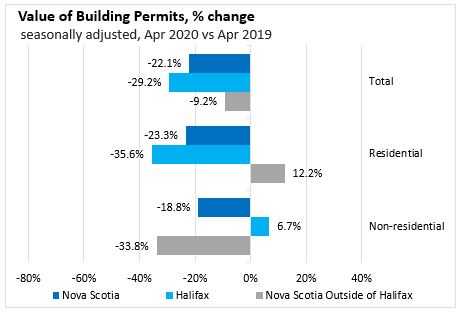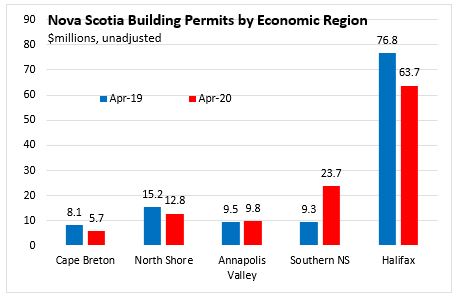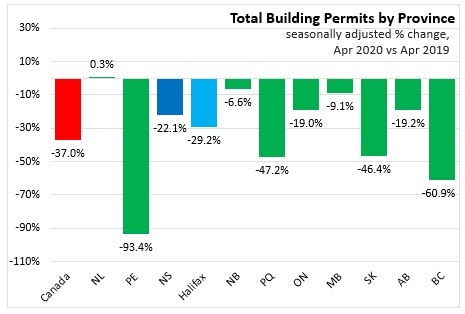For additional information relating to this article, please contact:
May 27, 2020BUILDING PERMITS, APRIL 2020 During the COVID-19 pandemic, comparisons of year-to-date averages and sums do not show Nova Scotia’s rapidly-changing economic situation. The DailyStats will focus on year-over-year comparisons, comparing one month with the same month in the prior year. Where possible the DailyStats will make comparisons of seasonally adjusted data from the pre-COVID-19 period (January and February 2020) with the period during which COVID-19 measures were in place from March 2020 onwards.

The monthly value of building permits (seasonally adjusted) issued in Nova Scotia decreased 43.1 per cent in April, following a (revised) increase of 56.4 per cent in March. Nova Scotia's residential permits decreased 31.5 per cent while non-residential building permits decreased 60.8 per cent. Monthly results for building permits are highly volatile.
The six-month moving average of residential permits trended modestly upwards through 2017 and then declined in early 2018. Afterwards, residential permits resumed an upward trend before flattening out over the 2019. The six-month moving average for non-residential permit values remained relatively flat from mid-2017 to late 2018. Since early 2019, non-residential permits have trended upward but have peaked at the end of the year and declined in 2020.
The trend in Nova Scotia building permit values largely reflects the trends in the Halifax market. The value of Halifax building permits decreased 48.5 per cent in April 2020, reflecting a 38.9 per cent decrease in residential permit values and a 66.5 per cent decrease in non-residential permit values.
The six-month moving average for residential permits in Halifax has been rising since mid-2016 except for a decline in the fall of 2017 and early 2018. Since then, Halifax residential permits trended upward before flattening out over the 2019 and declined in 2020. Non-residential permits in Halifax trended down starting in June 2017, though they have trended upward since the spring of 2019.

Outside the Halifax market, building permit values decreased 33.2 per cent in April 2020, reflecting a decline in residential permits (-14.4 per cent) and a decline in non-residential permits (-53.3 per cent). Non-residential permits trended upward outside of Halifax from mid-2017 to mid-2018 but have remained relatively flat in 2019 and have been declining in recent months. Residential permits were elevated for a period in 2019 and have been declining in recent months.

In April 2020, the value of Nova Scotia building permits was down 22.1 per cent compared to April 2019. Residential permits are down 23.3 per cent and non-residential permits are down 18.8 per cent for April 2020 vs April 2019. The increase in non-residential building permits reflect a decline in commercial (-18.7%), industrial (-6.8%) and institutional (-44.1%)
Halifax building permits were down 29.2 per cent in April 2020 as residential permits decreased 35.6 per cent and non-residential 6.7 per cent increased compared to April 2019. Building permits outside of Halifax were down 9.2 per cent.


Building permits in Nova Scotia's five economic regions totaled $115.8 million (unadjusted) in April 2020. The largest contributor was the Halifax region, with a combined residential and non-residential permit value of $63.7 million. In April 2020, the total value of residential and non-residential permits was down in Halifax, North Shore, and Cape Breton region. Total permits increased in Southern NS and Annapolis Valley compared to April 2019.

In April 2020, the number of residential dwelling-units created (seasonality adjusted) in Nova Scotia was down by 160 units compared to the April 2019. The number of single units was up both for Halifax (+37) and Nova Scotia outside of Halifax (+12). The number of multiple units created was down for Halifax (-231) and up for Nova Scotia outside of Halifax (+22).

Nationally, the total value of building permits plummeted 17.1 per cent to $6.0 billion in April. The decrease in April was the largest decline since a similar drop in October 2008 during the financial crisis. When combined with the March decline, the value of building permits has fallen by 28.1 per cent from February levels.
Residential building permit values (seasonally adjusted) were on an upward trend in 2016 but have levelled off since early 2017. National residential building permits were down 14.2 per cent in April. Non-residential building permit values rose through 2017 and peaked toward the end of the year, remaining relatively flat through 2018. Since the end of 2018, non-residential permits have risen modestly. National non-residential permit values were down 21.9 per cent in April.

Comparing April 2020 with April 2019, national residential building permit (seasonality adjusted) values were down 35.0 per cent, with declines in eight provinces. Prince Edward Island (-90.5 per cent) showed the largest decline in residential permits in percentage terms, followed by Newfoundland and Labrador (-65.8 per cent) and British Columbia (-63.7 per cent). Residential building permit values were up in two provinces in April 2020, New Brunswick (+16.8 per cent) and Saskatchewan (+16.4 per cent).

National non-residential permits (seasonality adjusted) are down 40.3 per cent in April 2020 compared with April 2019, with declines in nine provinces. Prince Edward Island (-97.1 per cent) had the largest decline followed by Saskatchewan (-70.7 per cent) and Quebec (-62.8 per cent). Non-residential permits only increased in Newfoundland and Labrador (+49.2 per cent).

In April 2020, the national value of total (residential and non-residential) building permits was down 37.0 per cent compared to April 2019. Total building permit values were down in nine provinces in April 2020, Prince Edward Island led with (-93.4 per cent) followed by British Columbia (-60.9 per cent) and Quebec (-47.2 per cent). Newfoundland and Labrador reported the increase over this period (+0.3 per cent).

Source: Statistics Canada Table 34-10-0066-01